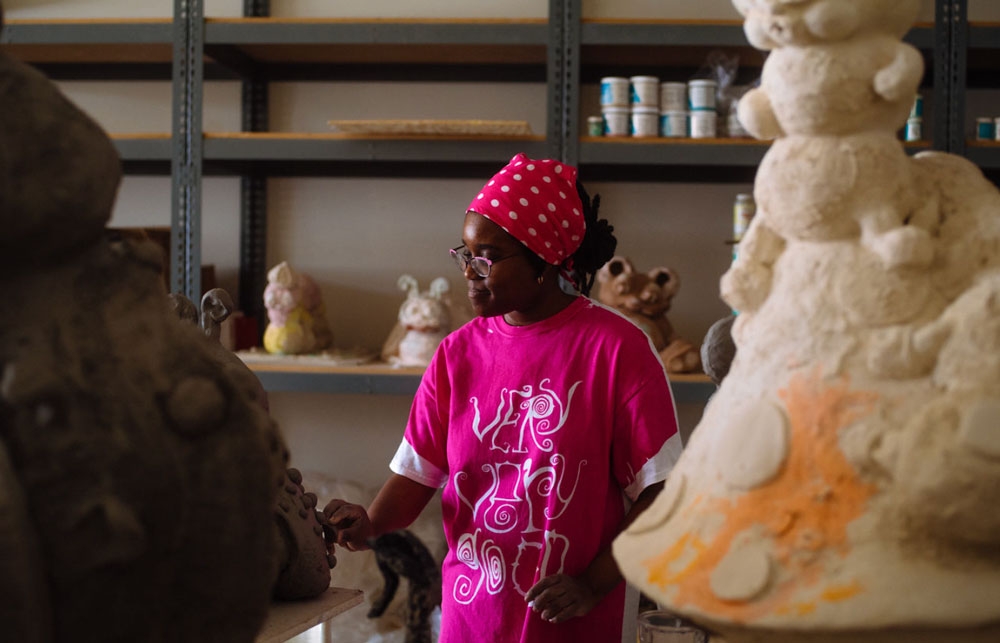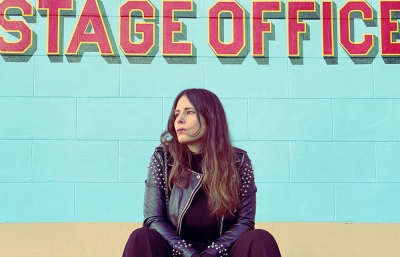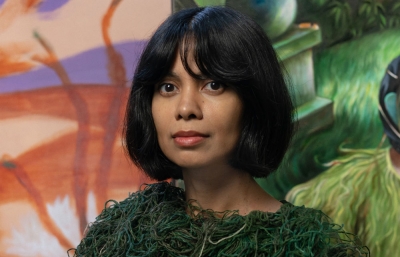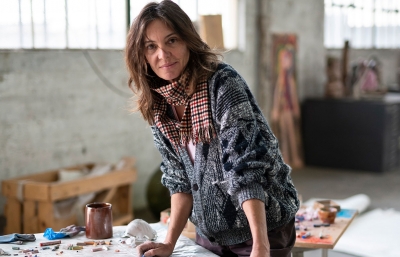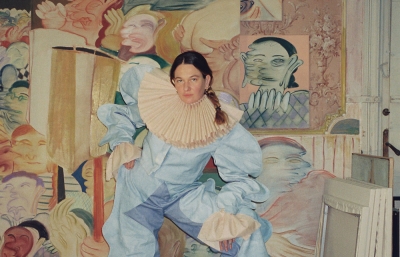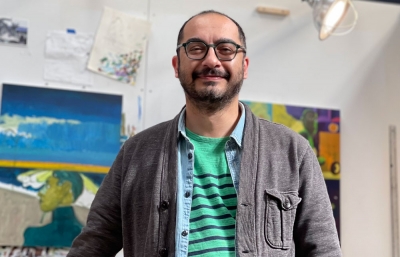Alake Shilling
The Lucky Ladybugs
Interview by Charles Moore // Portrait by Max Knight
Los Angeles-based multidisciplinary artist Alake Shilling appreciates the culture of her native city. Raised by a single mother who organized frequent trips to the art store, Shilling has always found creative inspiration in her surroundings. She infuses whimsy with the natural world to bring her ceramic characters to life, and can’t imagine being anywhere but LA, where the artist is “steeped in pop culture” alongside her peers. She hopes to one day complete a mural in Venice Beach, perhaps on the side of a favorite restaurant or simply alongside a fence or wall. In the meantime, one can assume she’ll continue to collect rave reviews as she shares her unique artistry with the world.
Shilling’s career has evolved naturally. She initially dabbled in drawing and animation before pivoting to oil painting, where viewers got a first taste of the abstract characters she creates. Mushrooms, frogs, bears, and ladybugs all come alive in vibrant color. The natural quality of oil paint appeals to her; the gemstones, minerals, and organic matter that comprise the pigment deeply resonate. In this way, ceramics proved a natural transition from painting—so much so that Shilling has come to refer to sculpture as her true destiny. Today she works in a studio by Santa Monica’s Bergamot Station Art Center, and creates her characters in 3D, full-time. The process is truly visceral because clay actually guides Shilling. She frequently sinks her hands into the material without a plan, then emerges from her space months later with a new creature in full bloom.

Also in bloom is Shilling’s resume, which includes a 2021 solo exhibition at the Jeffrey Dietrich Gallery and a collaboration with Disney, for whom the artist created a sculptural rendition of Mickey Mouse in celebration of the character’s 90th birthday. Shilling smiles when she considers her trajectory, disclosing that in 2020, a psychic informed her she would be well-known for her sculptures in the near future—captivating pieces composed of organic materials, glass, and gemstones—gleaming items sourced from her surroundings. Shilling knows she’ll figure it out. In the meantime, she continues to watch TV or go on YouTube, imbibing culture, researching animations and taking screenshots of images and colors, or even fashions, that appeal to her. It’s all part of her research.
Above all else, Shilling wants audiences to understand that there is no one-size-fits-all approach to Black art-making. Black artists, she explains, simply create—they cannot be pigeonholed—and the artist is doing her part to create works that might not look like what the public expects. Shilling’s abstract pieces and use of natural themes are only rarely associated with Black art. Elements like butterflies and tie-dye don’t fit the stereotype she wishes to overcome.
Shilling, nonetheless, strongly aligns with her identity as a Black artist. During her animation days, she recalls that she had to dig deep to find people who looked like her. “Do my opinions matter?” she once asked. Today she recognizes that they matter deeply, despite the fact that Shilling has forged her own path. Equipped with her talent and positivity, the artist will continue on her quest to normalize the nonconformity of self-expression.

Charles Moore: Tell me about where you're from and where you grew up.
Alake Shilling: I'm from Los Angeles and I grew up in West LA in Mid City. I feel like it's a very good part of the city to live in because it's close to such exciting surrounding areas like Koreatown, Clover City, Hollywood, and Beverly Hills. I guess I'm naming all the cities on the west side, but that's a part of LA I like the best. Should I say more about how I feel about LA?
Let’s talk more about your upbringing and how Los Angeles has informed you and formulated how you see the world, how you see art, and things like that.
Well, my mother was very hands-on and very supportive of my creative abilities. She always encouraged me to draw. She always took me to the art store to buy supplies. Whatever I needed, she was open to helping me get it. What’s so nice about LA is that it's a great place to be if you want to be creative because there's so much access to what's cool and interesting, like fashion and pop culture; and there are so many people who move here to be creative. It's good for that, though it can be very isolating since the biggest focus a lot of people have here is image and what's cool. You must be attached to some kind of community that's interesting here, and I think that influenced a lot of my art. I had easy access to places like Melrose, which was a big part of where I got my inspiration, whether it was from fashion, the interesting people, the comic book stores, and all the colors. Melrose was the epicenter of pop culture in LA. I found Universal Studios, City Walk and the La Brea Tar Pits very inspiring growing up, and I still do. I thought that big puddle of tar with the huge dino and mammoth was so majestical. I think these places helped a lot with getting ideas. LACMA was very close to my house, so I went there often in my youth. There was also this small water park, Monsoon Lagoon, in Redondo Beach that had a big impact on me creatively. I named my first solo show after that water park.

Speaking of that, tell me about how you found painting and how you would describe your style as a painter.
Well, for a long time I did animation, so I like drawing and animating. I didn't really understand painting. I was very far removed from the process, and my idea of painting fine art was that it was very stuffy, like you had to paint still lifes of bowls of fruit or portraits of people. I had no grasp of how vast the world of fine art and painting was. I got even more knowledge about it when I went to high school. In the 11th grade, I went to a boarding school called Axpo, where I learned so much about fine art and painting. But you had to paint! They didn't let you just do what you were used to doing in art. You had to do sculpture, you had to do painting, you had to draw. I think they covered all of the pillars of fine art except for ceramics.
I had to learn about painting because I needed to get my grade and I was very resistant because it scared me. I didn't feel confident in articulating what I wanted because I didn't feel I had the skills. But just like anything else, there are guidelines. Once you learn the guidelines, just like driving, you can do it. I can't drive either. I don't know why I use that as an example, but once I learned what you needed to know to paint, it was just easy, like riding a bike. And I felt really connected to the richness of the oil paint. And I don't know, somehow, I stopped drawing after that, after I learned how to paint. I didn't draw anymore.
So, you went from drawing to painting and you were mostly working in oil or acrylic paint, right?
I'm not sure, but I think the teacher I had at the time was an oil painter and she was very interested in the students learning how to paint with oil because it's more labor-intensive than acrylic. She wanted everyone to learn the proper way to use the materials, the paint, how to clean the brushes, how to mix the oils, and how to save the oil. There are so many things you must learn. The same goes for acrylic, but there are more things to learn with oil paint.
You've sort of gone away from painting as of late.
Yes, and that's one thing that I will say about oil paint. I never really stopped painting with oil. I like the natural quality, and the fact that oil paint comes from gemstones and minerals from the earth really excites me. I like that the pigments are like anything you could find in nature mixed with oil. And I think that's one reason I like ceramics and I like sculptures because they come from the earth. The organic quality really, really excites me and makes me want to use the material. I don't get the synthetic quality of certain materials. They don't inspire me, so that's one reason I like ceramics.

Right, and I feel like there's some sort of moment where an artist makes a transition, there’s a big leap to go from oil painting to ceramics. What inspired you to make that big transition to ceramics?
You would think it is a big leap. Normally I would agree, but I really feel like painting was circumstance. It was what was available to me, but sculpture is my destiny. I feel like I had been trying to be a sculptor through my painting by building up the paint, and mixing in the materials like sand and glitter, so it would really pop out and look almost like ceramics. When I got the opportunity to start working on ceramics, I felt like it just was second nature. I really feel like I am less of a painter the more I work on ceramics and sculpture. I think one day I might not paint at all. The only reason I continue is that people want paintings! Also, I can have a painting studio anywhere, but I can't have a ceramic studio anywhere, though I have been able to have access through the years. That's really what I want to do. I really love ceramics and I really want to continue making sculptures.
I know we've spoken about this in the past, but I think you have a very interesting process, and it would be good to hear it in your words directly. And by process, I mean from idea conception to finished product. I know that there are some unique characters that have informed you, characters that you like to continuously work with, and some that you created.
I just love to create characters. The sculptures are based on the characters I paint. They have a similar look, like eyes and noses, but it's more visceral and organic. I can't just say I'm going to make a dog and then make a dog. I just start with a form and see where it takes me. I might intend to make a bear or make something that’s a better snail. I just go with whatever I feel the clay wants to be, like osmosis almost. I just start touching the clay and working it around and something emerges. I don't really have a plan. I sometimes make sketches of things I have in mind, but whatever comes out most of the time is a surprise to me. The better I get at ceramics, the easier it is to control what I'm making, but even still, I will set out to make a beetle and it just turns into something else. But I always think in terms of organic things like animals or flowers, something from nature.

I know when we last spoke, you mentioned the sort of exploration of materials that you incorporate into your paintings—things like flour, salt, noodles, cotton balls, and Epsom salt…
Yeah, I like to do that with paintings. Also, I would like to incorporate similar things into my sculpture, like maybe marbles, pieces of tile, pennies, nails, or gemstones, but that can be a little bit complicated with ceramics because you must know what's going to react with the fire in the kiln. You definitely don't want to put anything in there that harms the kiln in any way. Because I'm not always sure about what materials to use, I always do my research. I once had a reading from a psychic, and they told me that I would be very well known for sculptures made from all different types of organic materials, glass and gemstones, and beautiful things. I know I'll figure it out because the psychic told me I will!
You have an interesting method of research. How did you go about it?
My favorite research is watching TV. I like pop culture and animation is very important too. For the visual language I use, I’ll go online and look up animations that I might not be familiar with. I’ll try to find them on YouTube, and take screenshots of action scenes because the picture becomes abstract. I kind of like the abstract effect that animations get when they're manipulated to form something new. That inspires me. I like looking at field guides, and, for example, I have a lot of guides on gemstones and frogs. I just look at the pictures and colors and keep a catalog of all of those images. And fashion, that’s a big part of my research too.

What are you working on these days?
I have a lot of deadlines because of Fall. December is always a big time in the art world. I'm trying to do all of my ceramics, as many as I can, while I have access to this kiln and this large space. Then, I don't know what else. I probably won't work on ceramics anymore because I don't have a kiln and I don't really see myself getting the kind of kiln I need anytime soon. I haven't painted in about three months, so I'm just working on the ceramics, and I feel like my work is getting bigger because of it. I have a big mushroom with a caterpillar in it that I’m working on now. I have about eight ceramics, and they're a lot larger than I normally make, so that's what I'm working on now.
I'm trying to finish some work for a show in Miami during Art Basel. And then in May 2023, I'm going to have a solo show at UTA. It's become normal that at the last minute when you think you’ve got your schedule set, something amazing presents itself.
@sillyshilli // This interview was originally published in our Winter 2023 Quarterly print edition

